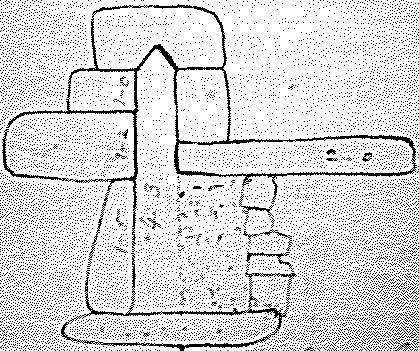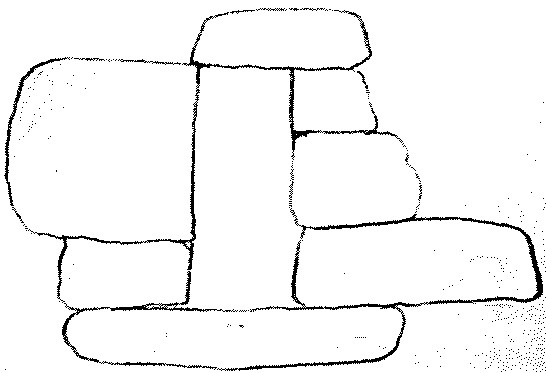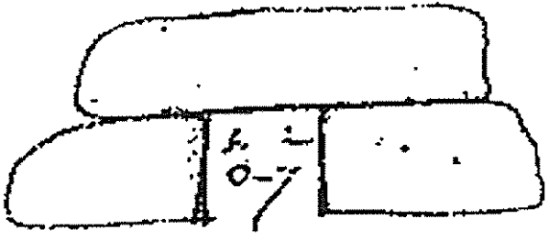June 25th 1839.
Dear Sir,
I find it exceedingly difficult to make sure of some of the minor names in the west of the parishes of Kilcummin and Killannin, and I incline to think that many of them are arbitrary. Those in Joyce's Country and Ballynahinch I have ascertained with great satisfaction.
I shall now say a few words about the antiquities of the dreary wilds through which I have wandered.
OF THE PARISH OF BALLYNAKILLE
Situation. This parish forms the northern part of the Barony of Ballynahinch, which was anciently called Conmaicne mara and now corrupted to Connamara. It is bounded on the north by that arm of the sea anciently called Caol Sháile ruadh now Killery; on the east by the parish of Ross in Joyce's Country; on the south by the Parishes of Moyros and Omey and on the west by the Atlantic Ocean.
Name. The name of this Parish is in Irish Baile na Cille, i.e. the Bally or town of the church, which is properly the name of the townland in which the original parish church stands. This church which stands in ruins at the foot of the hill of Cartron, about 5½ miles to north of Clifden, is dedicated to St. Ceannanach, and there is every reason to
believe that it was called Cill Cheannanaigh - Kilcanony - in the primitive ages of Christianity before the parish took its name from the townland. I have no distinct record of the history of this Saint except (in) the following notice (of the parish of Ballynakill) written by Roderic O'Flaherty about the year 1684, for the use of Sir William Petty.
Within Ardolin (Árd Oileán) Innisark and Bofin isles is Blackwik haven(a) where (in) the continent of Cliggin {(now) Claigeann} there is pilchard fishing and an Eyrie of Hawks. There was a weekly market at Cloggin(b) belonging to the Manor of Bunowan(c). In the same bay lies Dowras(d) on which pearle-breeding muscles are found. By this Haven of Dowras stands the Parish Church of Ballynakill, whose Patron, St. Kennanach is worshipped there {*** (on the 12th)} (e) of March, likely the same with the St. Kennanach of the middle island of Arran.
[NOTES BY JOHN O'DONOVAN]
(a) This name is now unknown in the country according to Mr. Blake of Rinvyle, and many of the aborigines whom I consulted.
(b) Now called in Irish Claigeann, and Anglicé Cleggan. It is a poor Country hamlet situated a short distance to the west of the old church of Ballynakill. It has no market at present nor does tradition remember that it ever had.
(c) This was the principal castle of that branch of the O'Flahertys located in Conmaicne mara or the Armoric Conmaicne. A small portion of its ruins are still visible near the house of John Augustus Mageoghegan O'Neill in the Parish of Ballindoon. The manor of this castle must have been very extensive when as it comprised Cleggan, wch. is situate 13 miles to the north of it.
(d) Now Dawros.
(e) His memory is now (annually) celebrated there on the 12th of March.
There are 16 oyster banks on this haven near Ballinakill.
North east of Dowras haven is the bay and narrow Straight of Coilshally roe(f) stretching into the lands between this Barony (Ballynahinshy) the Owles (Umhall) and Joyce's Country in which Bay is Rynmoyle (Rinn Mhil) Castle(g) and Blacksod Haven.(h) In Rynmoyle is a church(i) and (recté, at which) the memory of the seven daughters is celebrated.
[NOTES BY JOHN O'DONOVAN]
(f) Now the Killery harbour! What an extraordinary corruption in the course of a century and a half! The progress of the corruption is thus: Caol-sháile, i.e. the narrow brine, was first corrupted in the Irish itself to Caol-sháire to avoid the monotony of sound produced by the succession of ls; and next when the name was Anglicised it underwent another process of corruption in shortening the two first syllables!
1. Caol-Sháile - Keel-háály
2. Caol-Sháire - Keel-háry
3. Caol-áire - Kill-ary!This Strait is called Caol-sháile ruadh, i.e. the narrow red brine or salt water, throughout the Annals of the Four Masters.
(g) Still exists near Mr. Blake's house. It is a small rude (squa) castle of a quadrangular form, 33 feet by 30 and four stories high. Near it are the ruins of an old dwelling house, some centuries more modern. Tradition ascribes the erection of this Castle and house to the O'Flaherty, but I have no written document to prove or disprove this tradition. The townland of Rinvile is mentioned in an Inquisition temp. Car. I. but it makes no mention of the Castle.
(h) [Referred to on MS p. 26] This name is never applied to the haven at present, it having been dropped, in consequence of (its application to) another celebrated harbour in Erris. I have already shown in a letter from Binghamstown that Black Sod harbor took its name from a point of land of a black boggy appearance running into it, which is known to all the mariners (of those parts) as the Fod dubh or Black Sod. Now there is a similar piece of land near Col. Thompson's house called the Fod Dubh or Black sod, from which to all appearance, the whole bay was named in O'Flaherty's time. At present however, the whole Bay is called the Killary harbor, which is a better name as it distinguishes this from the celebrated Black Sod harbor in Erris.
(i) [Referred to on MS p. 26] This church is still in existence and traditionally remembered to have been erected by the seven daughters of the King of Britain - Seacht n-inghion righ Breatan ([Inserted in pencil:]? English) - after whom a holy well near the Church is called Tobar na seacht n-inghion ([Inserted in pencil:]? English) i.e. the well of the seven daughters, which is still esteemed sacred, and at which some of the natives say their prayers every Sunday. There was formerly at this well a flag stone called Leac na seacht n-inghion ([Inserted in pencil:]? English), (i.e.) the flag of the seven daughters, which was made the same use of as Leac Fhéichin and Claidhmín Chathasaigh, described by me in former letters, but some of the clergy caused it to be buried under ground "for special weighty reasons".
[Text resumed.]
Culfin(j) River falls into this bay and Laght-Fathocan(k) river between this and Joyce's Country, as also Bun-owen-an-coin river.(l)
[John O'Donovan's Notes resumed.]
This church of the seven daughters was remodified since the introduction of the Gothic style of architecture into Ireland. It is about 40 f. long and 15 f. broad. The door is placed in the north side wall near the west gable (facing the sea) which is very unusual in Churches of its age in Ireland, but the reason of its being so placed will be at once manifest. This doorway is in the pointed style but very rude and unornamented. It measures 5f. 9in. in height and 3f. 0 in breadth. The west gable is destroyed to the very foundation. The only part of the primitive work remaining is a window in the east gable, which is in the lancet style, measuring on the outside 4ft. 3in. in height and 0f. 7in. in breadth and thus constructed thus:

A short distance from this Church of the Seven Daughters are some standing stones called Liagauns, which are probably the remains of a pagan grave.
(j) [Referred to on MS p. 27] Culfin is now the name of a townland on the northern boundary of Ballynakill parish.
(k) [Referred to on MS p. 27] Now called Leacht Uí Fathachain, Laghtyfahaghaun.
(l) [Referred to on MS p. 27] This is now the name of the (a) townland, on either side of the mouth of which this river. Bun-abhann an Chuain signifies the mouth of the River of the harbor.
Besides these ancient remains mentioned by O'Flaherty there are (two) others, of which the one is but little known, (&) the other most celebrated as the sanctuary of a primitive Irish Saint. The first is a rude little church of extreme antiquity situated on Oileán dá chruinne, an island in the ocean exactly a mile to the north of Rinvyle house. This Church is the rudest I have yet seen. It measures on the outside 22 ft. in length and 14f. in breadth. The walls are 2f. 9in. in thickness, and are constructed of some very large and some very small stones but cemented with good mortar. The doorway, which was placed in the middle of the west gable, is destroyed down to the foundation stones but it can be ascertained that its breadth was 2ft. 6in. at the bottom. The only perfect feature is a small and exceedingly rude window in the east gable, It is about 2f. 0in. high and 9 inches wide on the outside and constructed thus: [Fig. 91]

They have no tradition of the saint or hermit of this island nor any tradition whatever in connexion with it except that it "admits of no burial within in" [? recté it]. There never was since the time of the saint a human body interred
within this church but one, and to the astonishment of the neighbouring peasants, {who, I must confess, do not know as much about the laws of nature or (the) nature of laws as Mr. Blake of Rinvyle,} the sacred clay or stones rather, of the sanctuary eructed him (it) from its bosom, and it was found the next morning at a place called Sméaróid, on the opposite side of the Continent, where children are now usually interred.
The other place not mentioned by O'Flaherty is of great celebrity. It is called Sal Roc, i.e. the track of St. Rocus, who is believed in that part of the country to have been the most miraculous Saint in those western parts. I have however no historical account of him nor is it likely that his history is now recoverable. No notice is taken of his Church in the name books but I trust that his sanctuary is marked on the plan.
The old church of Ballynakill, which appears to have been used (as the parish church) in Roderic O'Flaherty's time (the western part of this church is in the Gothic style and was built, according to tradition, by Edmond Laidir O'Flaherty, about 200 years ago) is in my opinion, modern except the east gable which seems to me to be as old as the time of St. Ceannfhionnach himself. It contains a small window nearly of the same dimensions and characteristics with the window in the old church
of the seven daughters above referred, but there is one difference that instead of being lancet headed, it is rectangular, thus:

St. Kenanach's holy well is situated about 1/8 mile to the east of his church. It seems a good spring, like most of the sacred wells of Ireland. It is enclosed by (a tor) a circular wall, which I do not believe to be ancient. The memory of the Saint is annually celebrated at this well on the 12th of March, which is the festival of his death {Solemnitas dormitationis ejus}.
Mr. Wakeman has not joined me yet. I expect him to-morrow.
John O'Donovan.
